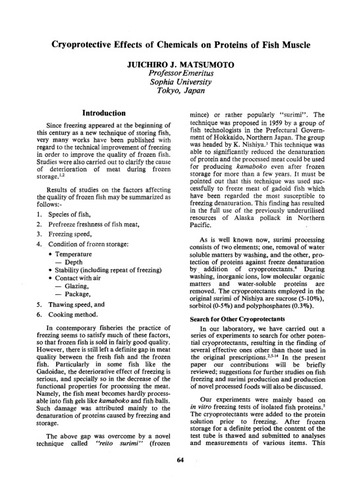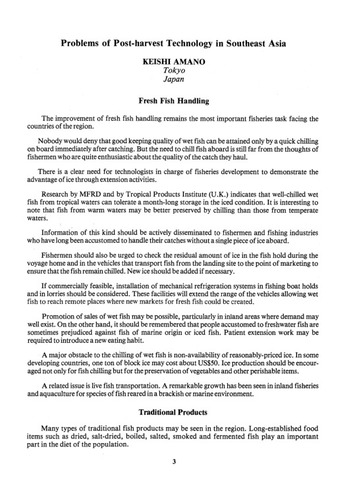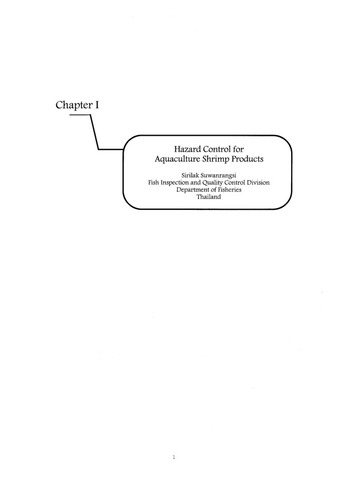08 SEAFDEC/MFRD Publications: Recent submissions
Ipinapakita ngayon ang mga item 161-180 ng 325
-
A case history of fish jelly product development in Sarawak, Malaysia
(Marine Fisheries Research Department, Southeast Asian Fisheries Development Center, 1988)The development of fish jelly processing in Sarawak, Malaysia, a technique first introduced in 1984, is discussed. Socio-economic factors affecting the development of the industry are examined, considering attitudes, ... -
Cryoprotective effects of chemicals on proteins of fish muscle
(Marine Fisheries Research Department, Southeast Asian Fisheries Development Center, 1988)A review is made of studies conducted on cryoprotectants for use in the frozen storage of processed fishery products, such as surimi. Some 150 compounds were screened for cryoprotective effects on fish actomyosin; the ... -
General introduction to marine processed products in Japan
(Marine Fisheries Research Department, Southeast Asian Fisheries Development Center, 1988)The marine fishery catch for Japan in 1984 was over 12 million tonnes; the sardine catch was high, although Alaska pollack showed a decrease. A brief account is given of imports and export, both worldwide and for Japan, ... -
Utilization and post-harvest technology of sardine, in relation to nutrition and health
(Marine Fisheries Research Department, Southeast Asian Fisheries Development Center, 1988)Fish consumption in Japan is very high compared with other countries; it is approximately 96 g daily per capita and provides a good balance of protein, fats and oils, and carbohydrates. The largest component of the fish ... -
Overview of current fish consumption and fish processing in Southeast Asia
(Marine Fisheries Research Department, Southeast Asian Fisheries Development Center, 1988)Following a brief account of the food fish supply in the Southeast Asian region, details are given of per capita fish consumption in the following countries: Brunei, Indonesia, Malaysia, Philippines, Singapore and Thailand. ... -
Improvement in fisheries post-harvest technology in Thailand
(Marine Fisheries Research Department, Southeast Asian Fisheries Development Center, 1988)Following a brief account of the fishery industry of Thailand, describing the fishery resources and the utilization of the fish landed, details are given of the fish processing sector. Cold storage and freezing facilities, ... -
Fish processing in Singapore
(Marine Fisheries Research Department, Southeast Asian Fisheries Development Center, 1988)An account is given of the fish processing industry in Singapore, which produces 4 major groups of fish products, namely frozen fish products, fish jelly products, snack food and seafood delicacies. Problems faced by the ... -
The fish processing industry in the Philippines: Status, problems and prospects
(Marine Fisheries Research Department, Southeast Asian Fisheries Development Center, 1988)An account is given of the fish processing industry of the Philippines. The various existing post-harvest technologies are described, considering fresh fish handling practices, fish processing technologies, new fish ... -
Problems of post-harvest technology in Southeast Asia
(Marine Fisheries Research Department, Southeast Asian Fisheries Development Center, 1988)Improvement of post-harvest technology in Southeast Asian countries and the various problems involved are discussed, considering the following topics: fresh fish handling; traditional products; fish products for export; ... -
Present status of fish processing activities in Malaysia
(Marine Fisheries Research Department, Southeast Asian Fisheries Development Center, 1988)An account is given of the fish processing industry of Malaysia; products consist of dried fish, fish crackers, shrimp past, fermented fish, fish satay, canned tuna/sardine, frozen prawn/fish/squid, and fish meal. Problems ... -
Development of fish products in Indonesia
(Marine Fisheries Research Department, Southeast Asian Fisheries Development Center, 1988)Details are given of the various processing methods used for fish landed in Indonesia. Data for the period 1983-85 indicate curing to be the most popular method, in particular dry salted and boiled fish. Problems involved ... -
Quality management for aquacultured shrimp
(Marine Fisheries Research Department, Southeast Asian Fisheries Development Center, 1997) -
Chemical determination of drug residues in seafoods using high performance liquid chromatography (HPLC)
(Marine Fisheries Research Department, Southeast Asian Fisheries Development Center, 1997) -
Analysis of antibiotic and drug residues in agrifoods and seafoods
(Marine Fisheries Research Department, Southeast Asian Fisheries Development Center, 1997) -
Determination of drug and chemical residue by HPLC
(Marine Fisheries Research Department, Southeast Asian Fisheries Development Center, 1997) -
A simple microbiological method for determining presence and for classifying of antibiotic residues in marine food products
(Marine Fisheries Research Department, Southeast Asian Fisheries Development Center, 1997) -
Sensory assessment of black tiger shrimp (Penaeus monodon)
(Marine Fisheries Research Department, Southeast Asian Fisheries Development Center, 1997) -
Hazard control for aquaculture shrimp products
(Marine Fisheries Research Department, Southeast Asian Fisheries Development Center, 1997) -
Toxic red tides and shellfish toxicity in southeast Asia: Proceedings of a consultative meeting held in Singapore 11-14 September 1984
(Marine Fisheries Research Department, Southeast Asian Fisheries Development Center; International Development Research Centre, 1984)The occurrence of toxic red tides and paralytic shellfish poisoning (PSP) have become more frequent in Southeast Asian waters in recent years. A consultative meeting was organised by the Southeast Asian Fisheries Development ... -
A summary of paralytic shellfish poisoning in Canada
(Marine Fisheries Research Department, Southeast Asian Fisheries Development Center; International Development Research Centre, 1984)Paralytic shellfish poisoning occurs along both the east and west coasts of Canada. Since 1973 there have been more than 300 documented cases of paralytic shellfish poisoning, resulting in about 35 deaths. Causative ...




















